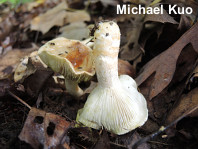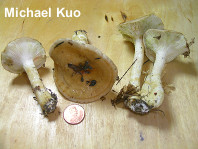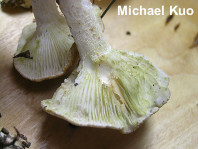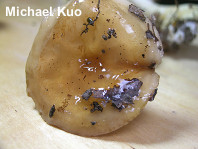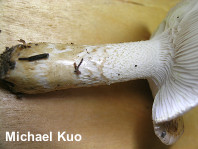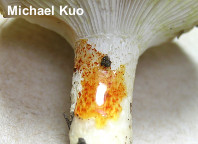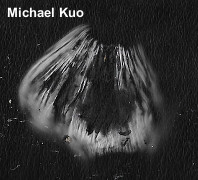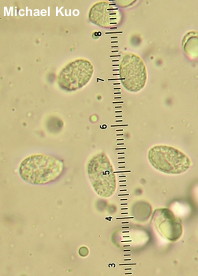| Major Groups > Gilled Mushrooms > Pale-Spored > Waxy Caps > Hygrophorus paludosus |

|
Hygrophorus paludosus [ Basidiomycota > Agaricales > Hygrophoraceae > Hygrophorus . . . ] by Michael Kuo Hygrophorus paludosus is a fairly distinctive waxy cap found under oaks and other hardwoods in the Midwest and eastern North America. I say "fairly" distinctive because it does not always exhibit its most distinguishing feature: the tendency of the gills to stain green as the mushroom matures. Without the green staining, Hygrophorus paludosus can look more or less like a host of whitish to orange, slimy species of Hygrophorus. However, close inspection reveals a few details that, when taken together, eliminate most identification contenders: the cap is whitish to pale orangish, but is usually covered with brownish orange gluten, making it appear more highly colored than it is underneath; the gills, by maturity, run down the stem; the stem features not only a sheath of the same orangish gluten found on the cap, but also a white, fibrillose sheath underneath the gluten; and the odor is not distinctive. Hygrophorus glutinosus is somewhat similar, and is often the name used for misidentified collections of Hygrophorus paludosus in which the green staining was absent, but its cap gluten is much more pale and whitish, its mature gills do not run down the stem (or do so only slightly), and it lacks the fibrillose sheath under the gluten on the stem. Microscopically the two species are indistinguishable. Description: Ecology: Mycorrhizal with oaks and other hardwoods; growing scattered to gregariously; late summer and fall (or over winter along the Gulf Coast); widely distributed in the Midwest and eastern North America. The illustrated and described collection is from Illinois. Cap: 3–6.5 cm; convex when young, becoming broadly convex or nearly flat; glutinous when fresh; bald; whitish to pale orangish, but the gluten is brownish orange (Hex D0A475) and often covers the entire cap surface; sometimes appearing zoned and/or wrinkled as the gluten dries out. Gills: Broadly attached to the stem or beginning to run down it at first, but by maturity running more deeply down the stem; close; short-gills frequent; white; usually developing yellowish green spots and discolorations with age. Stem: 5–7 cm long; 1–1.5 cm thick; nearly club-shaped at first, becoming more or less equal; dry and white near the apex, with tiny concolorous dots; sheathed for the bottom two-thirds with a copious veil of brownish orange gluten and, underneath the gluten, a white, fibrillose veil; the gluten drying and stretching out into chevron-like patterns and lines; basal mycelium white. Flesh: White; unchanging when sliced. Odor and Taste: Not distinctive. Chemical Reactions: KOH negative on cap surface; instantly dark orange on stem apex. Spore Print: White. Microscopic Features: Spores 8–11 x 4.5–6 µm; ellipsoid; smooth; hyaline, with minutely granular contents in KOH; inamyloid. Hymenial cystidia absent. Basidia 4-sterigmate. Lamellar trama divergent. Pileipellis an ixotrichoderm. REFERENCES: Peck, 1902. (Kauffman, 1918; Hesler & Smith, 1963; Smith, Smith & Weber, 1979.) Herb. Kuo 09301501. This site contains no information about the edibility or toxicity of mushrooms. |
© MushroomExpert.Com |
|
Cite this page as: Kuo, M. (2016, June). Hygrophorus paludosus. Retrieved from the MushroomExpert.Com Web site: http://www.mushroomexpert.com/hygrophorus_paludosus.html |
